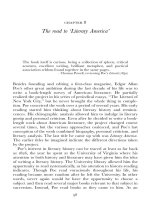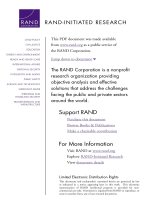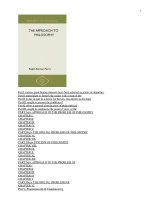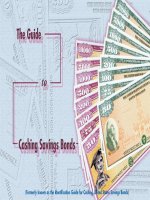The Road to Serfdom pptx
Bạn đang xem bản rút gọn của tài liệu. Xem và tải ngay bản đầy đủ của tài liệu tại đây (810.23 KB, 97 trang )
The Reader’s Digest condensed version of
The Road to SerfdomThe Road to Serfdom
FRIEDRICH A. HAYEK
The condensed version of The Road to Serfdom
by F. A. Hayek as it appeared in the April 1945
edition of Reader’s Digest
The Institute of Economic Affairs
First published in Great Britain in 1999
in the ‘Rediscovered Riches’ series by
The Institute of Economic Affairs
2 Lord North Street
Westminster
London sw1p 3lb
Reissued in the ‘Occasional Paper’ series in 2001
This condensed version of The Road to Serfdom © Reader’s Digest,
reproduced by kind permission
The Road to Serfdom is published in all territories outside the USA by Routledge.
This version is published by kind permission.
All other material copyright © The Institute of Economic Affairs 1999, 2001
Every effort has been made to contact the copyright holders associated with this
edition. In some cases this has not been possible. The IEA will be pleased to
include any corrections in the next edition.
All rights reserved. Without limiting the rights under copyright reserved above,
no part of this publication may be reproduced, stored or introduced into a
retrieval system, or transmitted, in any form or by any means (electronic,
mechanical, photocopying, recording or otherwise), without the prior written
permission of both the copyright owner and the publisher of this book.
A CIP catalogue record for this book is available from the British Library.
isbn 0 255 36530 6
Many IEA publications are translated into languages other than English or are
reprinted. Permission to translate or to reprint should be sought from the
General Director at the address above.
Typeset in Stone by MacGuru
Printed and bound in Great Britain by Hobbs the Printers
Those who would give up essential liberty to purchase a little
temporary safety deserve neither liberty nor safety.
Benjamin Franklin
Foreword by Edwin J. Feulner Jr 11
Introduction: Hayek, Fisher and The Road to Serfdom
by John Blundell
14
Preface to the Reader’s Digest condensed version of
The Road to Serfdom
26
Summary 27
The Road to Serfdom (condensed version) 31
Planning and power 32
Background to danger 34
The liberal way of planning 37
The great utopia 39
Why the worst get on top 43
Planning vs. the Rule of Law 49
Is planning ‘inevitable’? 51
Can planning free us from care? 53
Two kinds of security 58
Towards a better world 62
The Road to Serfdom in cartoons 63
About the IEA 82
CONTENTS
Friedrich A. Hayek (1899–1992) was born in Vienna and obtained
two doctorates from the University of Vienna, in law and political
economy. He worked under Ludwig von Mises at the Austrian In-
stitute for Business Cycle Research, and from 1929 to 1931 was a
lecturer in economics at the University of Vienna. His first book,
Monetary Theory and the Trade Cycle, was published in 1929. In 1931
Hayek was made Tooke Professor of Economic Science and Statis-
tics at the London School of Economics, and in 1950 he was ap-
pointed Professor of Social and Moral Sciences at the University of
Chicago. In 1962 he was appointed Professor of Political Economy
at the University of Freiburg where he became Professor Emeritus
in 1967. Hayek was elected a Fellow of the British Academy in 1944,
and in 1947 he organised the conference in Switzerland which re-
sulted in the creation of the Mont Pélerin Society. He was awarded
the Nobel Prize in Economics in 1974 and was created a Compan-
ion of Honour in 1984. In 1991 George Bush awarded Hayek the
Presidential Medal of Freedom. His books include The Pure Theory
of Capital, 1941, The Road to Serfdom, 1944, The Counter-Revolution
of Science, 1952, The Constitution of Liberty, 1960, Law, Legislation
and Liberty, 1973–9, and The Fatal Conceit, 1988.
9
THE AUTHORS
John Blundell
John Blundell is General Director of the Institute of Economic Af-
fairs. He was previously President of the Institute for Humane
Studies at George Mason University and the Atlas Economic Re-
search Foundation, founded by the late Sir Antony Fisher to estab-
lish ‘sister’ organisations to the IEA. He serves on the boards of
both organisations as well as on the board of the Mont Pélerin
Society.
Edwin J. Feulner Jr
Edwin J. Feulner Jr has served as President of the Heritage Founda-
tion since 1977. He is also the immediate past President of the
Mont Pélerin Society. He previously served in high-level positions
in both the legislative and executive branches of the federal
government. He received his Ph.D. from the University of Edin-
burgh and was awarded the Presidential Citizen’s Medal by
Ronald Reagan in 1989 for ‘being a leader of the conservative
movement by building an organisation dedicated to ideas and
their consequences . . .’
the road to serfdom
10
John Chamberlain characterised the period immediately fol-
lowing World War II in his foreword to the first edition of The
Road to Serfdom as ‘a time of hesitation’. Britain and the European
continent were faced with the daunting task of reconstruction and
reconstitution. The United States, spared from the physical de-
struction that marked Western Europe, was nevertheless recover-
ing from the economic whiplash of a war-driven economic
recovery from the Great Depression. Everywhere there was a
desire for security and a return to stability.
The intellectual environment was no more steady. The rise and
subsequent defeat of fascism had provided an extremely wide
flank for intellectuals who were free to battle for any idea short of
ethnic cleansing and dictatorial political control. At the same
time, the mistaken but widely accepted notion that the unpre-
dictability of the free market had caused the depression, coupled
with four years of war-driven, centrally directed production, and
the fact that Russia had been a wartime ally of the United States
and England, increased the mainstream acceptance of peace-time
government planning of the economy.
At this hesitating, unstable moment appeared the slim volume
of which you now hold the condensed version in your hands, F. A.
Hayek’s The Road to Serfdom. Occupying his spare time between
September 1940 and March 1944, the writing of The Road to
11
FOREWORD
Serfdom was in his own words more ‘a duty which I must not
evade’
1
than any calculated contribution to his curriculum vitae.
As Hayek saw it, he was merely pointing out ‘apprehensions which
current tendencies [in economic and political thought] must
create in the minds of many who cannot publicly express them
’
2
But as is often the case, this duty-inspired task had
tremendous consequences unintended by the author.
Hayek employed economics to investigate the mind of man,
using the knowledge he had gained to unveil the totalitarian
nature of socialism and to explain how it inevitably leads to ‘serf-
dom’. His greatest contribution lay in the discovery of a simple yet
profound truth: man does not and cannot know everything, and
when he acts as if he does, disaster follows. He recognised that
socialism, the collectivist state, and planned economies represent
the ultimate form of hubris, for those who plan them
attempt – with insufficient knowledge – to redesign the nature of
man. In so doing, would-be planners arrogantly ignore traditions
that embody the wisdom of generations; impetuously disregard
customs whose purpose they do not understand; and blithely con-
fuse the law written on the hearts of men – which they cannot
change – with administrative rules that they can alter at whim. For
Hayek, such presumption was not only a ‘fatal conceit’, but also
‘the road to serfdom’.
The impact of the simple ideas encapsulated in The Road to
Serfdom was immediate. The book went through six impressions
in the first 16 months, was translated into numerous foreign lan-
guages, and circulated both openly in the free world and clandes-
the road to serfdom
12
1 Hayek, F. A., The Road to Serfdom, London: Routledge, 1944, p. v.
2 Ibid., p. vii.
tinely behind the emerging iron curtain. It is no exaggeration to
say that The Road to Serfdom simultaneously prevented the emer-
gence of full-blown socialism in Western Europe and the United
States and planted seeds of freedom in the Soviet Union that
would finally bear fruit nearly 45 years later. Socialist catchphrases
such as ‘collectivism’ were stricken from the mainstream political
debate and even academic socialists were forced to retreat from
their defence of overt social planning.
But the true value of The Road to Serfdom is to be found not in
the immediate blow it dealt to socialist activists and thinkers – as
important as that was – but in the lasting impression it has made
on political and economic thinkers of the past 55 years. By Hayek’s
own admission, ‘this book . . . has unexpectedly become for me
the starting point of more than 30 years’ work in a new field’.
3
edwin j. feulner jr
November 1999
foreword
13
3 Although these words were written in 1976 it is safe to say that the influence of
The Road to Serfdom guided Hayek’s work until his death in 1992.
My story begins with a young Englishman named Lionel
Robbins, later Lord Robbins of Clare Market. In 1929, at the age of
only 30, he had been appointed Professor of Economics at the
London School of Economics and Political Science (LSE), a college
of the University of London. He was arguably the greatest English
economist of his generation, and he was fluent in German. This
skill alerted him to the work of a young Austrian economist,
Friedrich Hayek, and he invited his equally young counterpart to
lecture at the LSE. Such was the success of these lectures that
Hayek was appointed Tooke Professor of Economic Science and
Statistics at the LSE in 1931, and became an English citizen long be-
fore such status had become a ‘passport of convenience’.
In the 1930s John Maynard Keynes was in full flow. He was the
most famous economist in the world, and Hayek was his only real
rival. In 1936 Keynes published his infamous General Theory of
Employment, Interest and Money.
2
Hayek was tempted to demolish
this nonsense but he held back, for a very simple and very human
reason. Two years earlier, a now forgotten Keynesian tract (A Trea-
14
INTRODUCTION
HAYEK, FISHER AND
THE ROAD TO SERFDOM
1
1 This introduction is based on a speech given by the author on 26 April 1999
to the 33rd International Workshop ‘Books for a Free Society’ of the Atlas
Economic Research Foundation (Fairfax, VA) in Philadelphia, PA.
2 Keynes, J. M., The General Theory of Employment, Interest and Money, London,
Macmillan, 1936.
tise on Money)
3
had been ripped apart by Hayek in a two-part jour-
nal review. Keynes had shrugged off the attack with a smile, saying
as they passed one day in Clare Market: ‘Oh, never mind; I no
longer believe all that.’ Hayek was not about to repeat the demoli-
tion job on The General Theory in case Keynes decided, at some fu-
ture point, that he no longer believed in ‘all that’ either – a decision
I heard Hayek regret often in the 1970s.
War came and the LSE was evacuated from central London to
Peterhouse College, Cambridge. Typically, Keynes arranged
rooms for his intellectual arch-rival Hayek at King’s College where
Keynes was Bursar and – also typically – Hayek volunteered for fire
duty. That is, he offered to spend his nights sitting on the roof of
his college watching out for marauding German bombers.
It was while he sat out there at night that he began to wonder
about what would happen to his adopted country if and when
peace came. It was clear to Hayek that victory held the seeds of its
own destruction. The war was called ‘the People’s War’ because –
unlike most previous wars – the whole population had fought in
one way or another. Even pacifists contributed by working the
land to feed the troops. Hayek detected a growing sense of ‘As in
war, so in peace’ – namely that the government would own, plan
and control everything. The economic difficulties created by the
war would be immense: people would turn to government for a
way out. And so, as Hayek penned his great classic, The Road to
Serfdom, he was moved not only by a love for his adopted country
but also by a great fear that national planning, that socialism, that
the growth of state power and control would, inevitably, lead the
UK and the US to fascism, or rather National Socialism.
introduction
15
3Keynes, J. M., A Treatise on Money, London, Macmillan, 1930.
Antony Fisher, the man who did
So let me talk now about The Road to Serfdom and one man in par-
ticular who was moved by its lessons to do something. That man is
the late Antony George Anson Fisher, or AGAF as we referred to
him, and still do.
Fisher came from a family of mine owners, members of parlia-
ment, migrants and military men. He was born in 1915 and soon
followed by his brother and best friend Basil. His father was killed
by a Turkish sniper in 1917. Brought up in South East England by
his young widowed mother, an independent New Zealander from
Piraki, Akaroa, AGAF attended Eton and Cambridge where he and
his brother both learnt to fly in the University Air Squadron. On
graduating, Antony’s several initiatives included:
• a car rental firm – a success
• a plane rental firm – also a success; and
• the design and manufacture of a cheap sports car called the
Deroy – a failure because of a lack of power.
At the start of the war Antony and Basil volunteered for the
RAF and were soon flying Hurricanes in III Squadron in the Battle
of Britain. One day Basil’s plane was hit by German fire. He bailed
out over Selsey Bill but his parachute was on fire and both plane
and man plummeted to the ground, separately.
A totally devastated Antony was grounded for his own safety,
but used his time productively to develop a machine (the Fisher
Trainer) to teach trainee pilots to shoot better. He was also an avid
reader of Reader’s Digest. Every copy was devoured, read aloud to
his family, heavily underlined and kept in order in his study. His
first child, Mark, recalls a wall of Antony’s study lined with row
the road to serfdom
16
upon row of years – decades even – of copies of Reader’s Digest.
So how did our fighter pilot Fisher come across our academic
Hayek? What follows is the story I have pieced together. Not all
parts of it are accepted by all interested parties, but the pieces do
fit. So this is my story and I’m sticking to it.
The marriage of true minds
The Road to Serfdom was published in March 1944 and, despite
wartime paper shortages, it went through five reprints in the UK in
15 months. In spite of this, owing to wartime paper rationing, the
publishers, Routledge, were unable to keep up with demand and
Hayek complained that The Road to Serfdom had acquired a repu-
tation for being ‘that unobtainable book’.
4
It was such an incredi-
ble hit that Hayek lost track of the reviews and critics were moved
to write whole books attacking him in both the UK and the US. Dr
Laurence Hayek, only son of F. A. Hayek, owns his late father’s
own first edition copy of The Road to Serfdom as well as the print-
ers’ proof copy with Hayek’s corrections. On the inside back cover
of the former Hayek began listing the reviews as they came out.
The list reads as follows:
Tablet 11/3/44 (Douglas Woodruff)
Sunday Times 12/3 (Harold Hobson one
or two sentences)
9/4 (G. M. Young)
Birmingham Post 14/3 (TWH)
introduction
17
4 Quoted in Cockett, R., Thinking the Unthinkable: Think Tanks and the Economic
Counter-Revolution, 1931–1983, London, Fontana, 1995, p. 85.
Yorkshire Post 29/3
Financial News 30/3
Listener 30/3
Daily Sketch 30/3 (Candidus)
Times Literary Supplement 1/4
Spectator 31/3 (M. Polanyi)
Irish Times 25/3
Observer 9/4 (George Orwell)
Manchester Guardian 19/4 (W)
But, as Hayek said to me in 1975, they started coming so fast he
lost track and stopped recording them.
In early 1945 the University of Chicago Press published the US
edition of The Road to Serfdom and, like Routledge in the UK, found
themselves unable to meet the demand for copies owing to paper
rationing. However, in April 1945 the book finally reached a mass
audience when the Reader’s Digest published their condensed
version. (Hayek thought it impossible to condense but always
commented on what a great job the Reader’s Digest editors did.)
Whereas the book publishers had been dealing in issues of four or
five thousand copies, the Reader’s Digest had a print run which was
measured in hundreds of thousands. For the first and still the only
time, they put the condensed book at the front of the magazine
where nobody could miss it – particularly a Digest junkie like
Fisher.
The Reader’s Digest appeared while Hayek was on board a ship
en route to the USA for a lecture tour which had been arranged to
coincide with the US book publication. He arrived to find himself
a celebrity:
the road to serfdom
18
introduction
19
. . . I was told all our plans were changed: I would be going
on a nationwide lecture tour beginning at NY Town Hall . . .
Imagine my surprise when they drove me there the next day
and there were 3,000 people in the hall, plus a few score
more in adjoining rooms with loudspeakers. There I was,
with this battery of microphones and a veritable sea of
expectant faces .
5
Now I get to the detective work. That late spring/early summer
of 1945 saw both Hayek and Fisher on the move. Hayek had spent
the whole of the war at Cambridge but now it was safe for the LSE
to return to London. Fisher had spent the war stationed all over
the UK training pilots in gunnery and rising to the rank of
Squadron Leader. He too was on the move to the War Office (now
the Ministry of Defence) in central London, just a ten-minute walk
from the LSE. Laurence Hayek and the LSE both confirm the dates
of Hayek’s move, while Fisher’s RAF record, recently obtained
from the Ministry of Defence by his elder son Mark, clearly dates
his.
Forty years later both Hayek and Fisher were not overly helpful
about exactly what happened next. Hayek in particular used to
claim he had absolutely no recollection whatsoever of Fisher ever
coming to him for advice. Fisher on the other hand was always
very clear and very consistent about the dialogue – almost verba-
tim – but not so helpful on exactly how it happened. Here is how I
believe it came about.
Fisher, the Digest junkie, is already politically active and is also
worried about the future for his country. The April 1945 edition
5 Interview with Hayek in The Times, 5 May 1985, quoted in Cockett, op. cit.,
pp. 100–101.
lands on his desk as he is moving to London and, after reading the
cover story, he notes on the front that the author is at the Univer-
sity of London. A phone call establishes that the LSE is back in
place and, one lunchtime or late one afternoon, Fisher makes the
short walk from his office to the LSE and knocks on Hayek’s door.
Fisher also recalled the physical setting of Hayek’s office in minute
and accurate detail including its proximity to that of the dreaded
Harold Laski. Fisher claimed that after small talk (which neither
excelled at) the conversation went like this:
Fisher I share all your worries and concerns as expressed in The
Road to Serfdom and I’m going to go into politics and put it
all right.
Hayek No you’re not! Society’s course will be changed only by a
change in ideas. First you must reach the intellectuals, the
teachers and writers, with reasoned argument. It will be
their influence on society which will prevail, and the politi-
cians will follow.
I have this quote framed above my desk alongside Keynes’s
famous line: ‘The ideas of economists and political philosophers,
both when they are right and when they are wrong, are more
powerful than is commonly understood. Indeed the world is ruled
by little else. Practical men, who believe themselves to be quite
exempt from any intellectual influences, are usually the slaves of
some defunct economist.’
6
Finally on this issue, let me quote Fisher’s own words of 3 July
1985 when he spoke at a party at the IEA to celebrate its 30th
the road to serfdom
20
6 Keynes, The General Theory of Employment, Interest and Money, op. cit., p. 383.
birthday. (This would have been the 30th anniversary of the IEA’s
first bookin June 1955rather than incorporationin November 1955
or theactual openingin 1957.)At thatparty inJuly 1985Fisher said:
It was quite a day for me when Friedrich Hayek gave me
some advice which must be 40 years ago almost to the day and
which completely changed my life. Friedrich got me started
. and two of the things he said way back are the things
which have kept the IEA on course. One is to keep out of
politics and the other is to make an intellectual case . . . if
you can stick to these rules you keep out of a lot of trouble
and apparently do a lot of good.
As I said, 30 years later, on countless occasions, Hayek did not
dispute the event or disown the advice, he simply said he could not
remember. But it is of course very Hayekian advice and very much
in keeping with his classic essay ‘The Intellectuals and Socialism’,
which came out just a few years later and which has just been re-
published by the IEA.
7
This was hardly a blueprint for action –
‘reach the intellectuals’ – and indeed the next decade saw little
direct fallout from that conversation, although three American
intellectual entrepreneurs who had also sought out Hayek did get
the ball rolling in the US.
The road to the IEA
Hayek taught at the LSE, got divorced in Arkansas, remarried,
moved to Chicago and wrote The Constitution of Liberty.
introduction
21
7 Hayek, F. A., The Intellectuals and Socialism, Rediscovered Riches No. 4, London,
IEA, 1998.
Fisher tried stockbroking, became a farmer, wrote a very pre-
scient monograph, ‘The Case for Freedom’,
8
imported the idea of
factory-farming of chickens, championed liberty in many different
campaigns, visited the US looking for institute models he could
copy, published The Free Convertibility of Sterling by George
Winder,
9
incorporated the Institute of Economic Affairs, hired
Ralph Harris and, as he always did, having hired the talent let it rip
with a very hands-off approach to management. (When in 1987 he
entrusted to me the future of the Atlas Economic Research
Foundation, the body dedicated to building new IEAs around the
world, he made it very clear that he was there if I wanted his help
but that he really did expect me to crack on on my own.)
To begin with, in the late 1950s, it was not at all clear what the
IEA would do. The exchange control book by Winder had been
short, easily understood and on a fairly narrow but important
topic. It had sold out its 2,000 print run very quickly because of
Henry Hazlitt’s review in Newsweek. Unfortunately the printer who
had also sold the book for Antony went bankrupt, and the 2,000
names and addresses of the purchasers were lost. But Fisher had
visited the Foundation for Economic Education in Irvington-
on-Hudson, NewYork, hadbeen exposedto itsmagazine, TheFree-
man, and still adored Reader’s Digest. Harris had been a party po-
litical man turned academic turned editorial writer, while Arthur
Seldon, the first editorial director, had been a research assistant to
the famous LSE economist Arnold Plant before becoming chief
economist of a brewers’ association. Out of this mish-mash of ex-
periences – academic, business, political, journalistic – came the
the road to serfdom
22
8 Fisher, A., The Case for Freedom, London, Runnymede Press, undated.
9 Winder, G., The Free Convertibility of Sterling, London, The Batchworth Press for
the Institute of Economic Afrairs, 1955.
distinctive IEA approach of short monographs containing the very
best economics in good, jargon-free English, written by academics
(mostly) or quasi-academics, in language accessible to the layman
but still of use to the expert.
In the early days it was hard to find authors, hard to raise
money and hard to get reviews and sales. At times everybody had
to down pens to raise money or quickly pick up pens to co-author
a paper. The first clear success of this venture – inspired by The
Road to Serfdom, advised by Hayek, implemented by Fisher and
run by Harris and Seldon – was the repeal of Resale Price Mainte-
nance in 1964, a fantastic reform. It effectively outlawed the
prevailing practice by which manufacturers priced goods – they
literally stamped the price on the article – and discounting was
illegal. There was no such thing as shopping around. This change
alienated the small-business vote and put the Tories out for six
years, but it transformed the UK economy and allowed a nation of
shopkeepers to spread their wings. It was clearly heralded by a
1960 IEA study, Resale Price Maintenance and Shoppers’ Choice by
Basil Yamey.
10
Other successes followed and the IEA’s impetus
grew, but what was happening to Hayek and Fisher?
Hayek had moved from Chicago back to Europe, and in
December 1974 received the Nobel Prize. He was 75 and his health
had not been good. He was also depressed. However the prize (and
the big cheque) cheered him up no end.
Fisher had sold the chicken business for millions and had put a
large part of his minority share into an experimental turtle farm in
the Cayman Islands. Well, the experiment worked brilliantly but
introduction
23
10 Yamey, B. S., Resale Price Maintenance and Shoppers’ Choice, Hobart Paper No. 1,
London, IEA, 1960.
the environmentalists closed down his largest market – the US.
11
He refused to hide behind limited liability and used the balance of
his fortune to pay off all debts.
1974 – now 30 years after The Road to Serfdom – was a big year
for Fisher too, because, free from business concerns, he was able to
respond to businessmen and others around the world who noted
the IEA’s growing influence and came to him for advice.
Sowing the seed
So the entrepreneur turned fighter pilot turned gunnery trainer
turned stockbroker turned dairy farmer turned chicken pioneer
turned turtle saviour became the Johnny Appleseed of the free-
market movement, going all over the world and setting up new
IEA-type operations.
First he joined the very young Fraser Institute in Vancouver,
BC; quickly moved on to help Greg Lindsay and the Centre for
Independent Studies in Australia; hired David Theroux, recently
departed from the Cato Institute, to set up the Pacific Research
Institute in San Francisco; gave support to the Butler brothers and
Madsen Pirie as they founded the Adam Smith Institute in
London; and incorporated with William Casey the Manhattan
Institute where, as they did so, they sat on movers’ boxes in an
otherwise empty office.
It took ten years to give birth to Institute No. 1 – the IEA. For all
but twenty years it was the only one in the family; in just six years
five more were born, and then the fun really started. In 1981 Fisher
the road to serfdom
24
11 For a full account see Fosdick, P. and S., Last Chance Lost: Can and Should Farm-
ing Save the Green Sea Turtle?, York, PA, Irvin S. Naylor, 1994.









